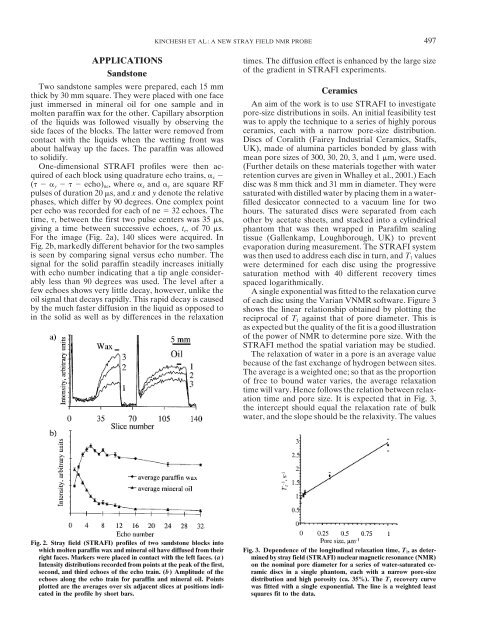Stray Field Nuclear Magnetic Resonance of Soil Water ...
Stray Field Nuclear Magnetic Resonance of Soil Water ...
Stray Field Nuclear Magnetic Resonance of Soil Water ...
Create successful ePaper yourself
Turn your PDF publications into a flip-book with our unique Google optimized e-Paper software.
KINCHESH ET AL.: A NEW STRAY FIELD NMR PROBE 497APPLICATIONStimes. The diffusion effect is enhanced by the large sizeSandstone<strong>of</strong> the gradient in STRAFI experiments.Two sandstone samples were prepared, each 15 mmthick by 30 mm square. They were placed with one faceCeramicsjust immersed in mineral oil for one sample and in An aim <strong>of</strong> the work is to use STRAFI to investigatemolten paraffin wax for the other. Capillary absorption pore-size distributions in soils. An initial feasibility test<strong>of</strong> the liquids was followed visually by observing the was to apply the technique to a series <strong>of</strong> highly porousside faces <strong>of</strong> the blocks. The latter were removed from ceramics, each with a narrow pore-size distribution.contact with the liquids when the wetting front was Discs <strong>of</strong> Coralith (Fairey Industrial Ceramics, Staffs,about halfway up the faces. The paraffin was allowed UK), made <strong>of</strong> alumina particles bonded by glass withto solidify.mean pore sizes <strong>of</strong> 300, 30, 20, 3, and 1 m, were used.One-dimensional STRAFI pr<strong>of</strong>iles were then acquired(Further details on these materials together with water<strong>of</strong> each block using quadrature echo trains, x retention curves are given in Whalley et al., 2001.) Each( y echo) ne , where x and y are square RF disc was 8 mm thick and 31 mm in diameter. They werepulses <strong>of</strong> duration 20 s, and x and y denote the relative saturated with distilled water by placing them in a waterphases,which differ by 90 degrees. One complex point filled desiccator connected to a vacuum line for twoper echo was recorded for each <strong>of</strong> ne 32 echoes. The hours. The saturated discs were separated from eachtime, , between the first two pulse centers was 35 s, other by acetate sheets, and stacked into a cylindricalgiving a time between successive echoes, t e ,<strong>of</strong>70s. phantom that was then wrapped in Parafilm sealingFor the image (Fig. 2a), 140 slices were acquired. In tissue (Gallenkamp, Loughborough, UK) to preventFig. 2b, markedly different behavior for the two samples evaporation during measurement. The STRAFI systemis seen by comparing signal versus echo number. The was then used to address each disc in turn, and T 1 valuessignal for the solid paraffin steadily increases initially were determined for each disc using the progressivewith echo number indicating that a tip angle consider- saturation method with 40 different recovery timesably less than 90 degrees was used. The level after a spaced logarithmically.few echoes shows very little decay, however, unlike the A single exponential was fitted to the relaxation curveoil signal that decays rapidly. This rapid decay is caused <strong>of</strong> each disc using the Varian VNMR s<strong>of</strong>tware. Figure 3by the much faster diffusion in the liquid as opposed to shows the linear relationship obtained by plotting thein the solid as well as by differences in the relaxation reciprocal <strong>of</strong> T 1 against that <strong>of</strong> pore diameter. This isas expected but the quality <strong>of</strong> the fit is a good illustration<strong>of</strong> the power <strong>of</strong> NMR to determine pore size. With theSTRAFI method the spatial variation may be studied.The relaxation <strong>of</strong> water in a pore is an average valuebecause <strong>of</strong> the fast exchange <strong>of</strong> hydrogen between sites.The average is a weighted one; so that as the proportion<strong>of</strong> free to bound water varies, the average relaxationtime will vary. Hence follows the relation between relaxationtime and pore size. It is expected that in Fig. 3,the intercept should equal the relaxation rate <strong>of</strong> bulkwater, and the slope should be the relaxivity. The valuesFig. 3. Dependence <strong>of</strong> the longitudinal relaxation time, T 1 , as deter-mined by stray field (STRAFI) nuclear magnetic resonance (NMR)on the nominal pore diameter for a series <strong>of</strong> water-saturated ceramicdiscs in a single phantom, each with a narrow pore-sizedistribution and high porosity (ca. 35%). The T 1 recovery curvewas fitted with a single exponential. The line is a weighted leastsquares fit to the data.Fig. 2. <strong>Stray</strong> field (STRAFI) pr<strong>of</strong>iles <strong>of</strong> two sandstone blocks intowhich molten paraffin wax and mineral oil have diffused from theirright faces. Markers were placed in contact with the left faces. (a)Intensity distributions recorded from points at the peak <strong>of</strong> the first,second, and third echoes <strong>of</strong> the echo train. (b) Amplitude <strong>of</strong> theechoes along the echo train for paraffin and mineral oil. Pointsplotted are the averages over six adjacent slices at positions indicatedin the pr<strong>of</strong>ile by short bars.















